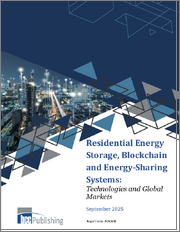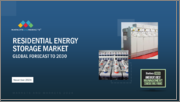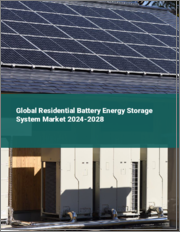
|
시장보고서
상품코드
1800274
세계의 주택용 에너지 저장 시장 예측(2025-2030년)Residential Energy Storage Market - Forecasts fom 2025 to 2030 |
||||||
세계의 주택용 에너지 저장 시장은 CAGR 16.26%로 확대되어 2025년 18억 달러에서 2030년 38억 2,200만 달러로 성장할 것으로 예측됩니다.
주택용 에너지 저장 세계 시장은 정전 빈도 증가, 태양광 발전(PV) 시스템의 채용 증가, 에너지 회복력에 대한 소비자 수요 증가에 의해 2025년부터 2030년까지 강력한 성장을 이룰 것으로 예측됩니다. 주거용 에너지 저장 시스템은 일반적으로 리튬 이온 배터리, 인버터 및 감시 메커니즘으로 구성되어 주택 소유자가 태양전지판과 송전망에서 에너지를 저장하여 피크 수요 및 정전 시 사용할 수 있습니다. 시장은 리튬 이온 기술의 진보와 지원 정책에 힘입어 북미가 선도하고 아시아태평양이 높은 성장 가능성을 보여줍니다. 과제는 초기 비용의 높이와 규제의 복잡성을 포함합니다.
시장 성장 촉진요인
정전 빈도 증가
허리케인, 산불, 폭풍우 등 기후 변화가 일으키는 이상 기상으로 인해 정전 발생률이 높아지고 있는 것이 주택용 에너지 저장 시장의 주요 촉진요인입니다. 선진국의 노후화된 전력망은 점점 고장나기 쉬워지고 있어 신뢰성이 높은 백업 솔루션이 필요해지고 있습니다. 이러한 정전은 가정이나 중요한 인프라를 혼란시키기 때문에 무정전 전력 공급을 확보하는 축전 시스템의 필요성이 부각되고 있습니다. 정전시에 사용하기 위해 태양에너지와 그리드 에너지를 저장할 수 있는 시스템에 대한 수요가 특히 날씨 관련 혼란이 일어나기 쉬운 지역에서 시장 성장을 뒷받침하고 있습니다.
태양광 발전 시스템 채용 증가
주택용 태양광 발전 설비의 급증은 축전 시스템, 특히 리튬 이온 배터리를 사용한 축전 시스템 수요를 촉진하고 있습니다. 이 배터리는 방전 깊이가 깊고 왕복 효율이 높기 때문에 잉여 태양에너지 저장에 이상적입니다. 축전 시스템을 태양광 발전 시스템과 통합함으로써 주택 소유자는 에너지의 자급 자족을 극대화하고 송전망에 대한 의존도를 줄일 수 있습니다. 인터넷 미터링 개혁과 금융 우대 조치 등의 지원 정책이 태양광 발전과 축전을 결합한 솔루션의 채용을 더욱 강화하고 시장 확대에 박차를 가하고 있습니다.
리튬 이온 기술의 발전
리튬 이온 배터리 기술의 급속한 진보는 주거용 에너지 저장 시스템의 성능과 가격을 향상시키는 주요 촉진요인입니다. 배터리 설계의 혁신은 에너지 밀도, 수명, 효율성을 향상시키고 가정의 다양한 에너지 수요를 충족시킵니다. 주요 기업에 의한 협력적인 노력과 신제품 출시는 리튬 이온 솔루션 시장 개척을 가속화하고 시장을 독점하는 기술이 되어 주택용도에서의 폭넓은 채용을 지원하고 있습니다.
시장 성장 억제요인
주택용 에너지 저장 시장은 배터리 시스템, 설치 및 유지보수에 필요한 초기 비용이 높다는 과제에 직면하고 있으며, 이는 비용에 민감한 소비자의 채용을 방해할 수 있습니다. 그리드 접속 기준이나 허가 요건이 다른 등, 규제가 복잡한 것도 시장 진입의 장벽이 되고 있습니다. 또한 첨단 시스템의 설치 및 유지 보수에는 숙련된 기술자가 필요하기 때문에 전문 지식이 부족한 지역에서는 성장이 제한 될 수 있습니다. 지속적인 확장을 위해서는 비용 절감과 규제 합리화를 통해 이러한 과제를 해결하는 것이 필수적입니다.
목차
제1장 주요 요약
제2장 시장 현황
- 시장 개요
- 시장의 정의
- 조사 범위
- 시장 세분화
제3장 비즈니스 상황
- 시장 성장 촉진요인
- 시장 성장 억제요인
- 시장 기회
- Porter's Five Forces 분석
- 업계 밸류체인 분석
- 정책 및 규정
- 전략적 제안
제4장 기술 전망
제5장 주택용 에너지 저장 시장 : 파워 유형별
- 소개
- 3-6kW
- 6-10kW
- 10-20kW
제6장 주택용 에너지 저장 시장 : 기술 유형별
- 소개
- 리튬 이온
- 납축전지
- 플로우
- 염화니켈 나트륨
- 나트륨 이온
- 전고체 전지
- 기타
제7장 주택용 에너지 저장 시장 : 접속 유형별
- 소개
- 온그리드
- 오프 그리드
제8장 주택용 에너지 저장 시장 : 소유권별
- 소개
- 고객 소유
- 유틸리티 소유
- 타사 소유
- 근거
제9장 주택용 에너지 저장 시장 : 지역별
- 소개
- 북미
- 미국
- 캐나다
- 멕시코
- 남미
- 브라질
- 아르헨티나
- 기타
- 유럽
- 독일
- 프랑스
- 영국
- 스페인
- 기타
- 중동 및 아프리카
- 사우디아라비아
- 아랍에미리트(UAE)
- 기타
- 아시아태평양
- 중국
- 인도
- 일본
- 한국
- 인도네시아
- 태국
- 기타
제10장 경쟁 환경과 분석
- 주요 기업과 전략 분석
- 시장 점유율 분석
- 합병, 인수, 합의 및 협업
- 경쟁 대시보드
제11장 기업 프로파일
- Tesla
- BYD Motors Inc.
- Trojan Battery Company, LLC
- Saft
- Enphase Energy
- Magellan Power
- LG Energy Solution
- Huawei Technologies Co., Ltd.
- Samsung SDI Co., Ltd.
- SMA Solar Technology AG
제12장 부록
- 통화
- 전제조건
- 기준연도과 예측연도의 타임라인
- 이해 관계자의 주요 이점
- 조사 방법
- 약어
The Residential Energy Storage Market is expected to grow from USD 1.800 billion in 2025 to USD 3.822 billion in 2030, at a CAGR of 16.26%.
The global residential energy storage market is projected to experience robust growth from 2025 to 2030, driven by the increasing frequency of power outages, rising adoption of solar photovoltaic (PV) systems, and growing consumer demand for energy resilience. Residential energy storage systems, typically comprising lithium-ion batteries, inverters, and monitoring mechanisms, enable homeowners to store energy from solar panels or the grid for use during peak demand or outages. The market is propelled by advancements in lithium-ion technology and supportive policies, with North America leading and Asia-Pacific showing strong growth potential. Challenges include high initial costs and regulatory complexities.
Market Drivers
Increasing Frequency of Power Outages
The growing incidence of power outages, driven by climate change-induced extreme weather events like hurricanes, wildfires, and storms, is a primary driver of the residential energy storage market. Aging electrical grids in developed countries are increasingly vulnerable to failures, necessitating reliable backup solutions. These outages disrupt households and critical infrastructure, highlighting the need for energy storage systems to ensure uninterrupted power supply. The demand for systems that can store solar or grid energy for use during outages is boosting market growth, particularly in regions prone to weather-related disruptions.
Rising Adoption of Solar PV Systems
The surge in residential solar PV installations is driving demand for energy storage systems, particularly those using lithium-ion batteries. These batteries offer high depth of discharge and round-trip efficiency, making them ideal for storing excess solar energy. The integration of storage with solar systems allows homeowners to maximize energy self-sufficiency and reduce reliance on the grid. Supportive policies, such as net metering reforms and financial incentives, further encourage the adoption of combined solar and storage solutions, fueling market expansion.
Advancements in Lithium-Ion Technology
Rapid advancements in lithium-ion battery technology are a key growth driver, enhancing the performance and affordability of residential energy storage systems. Innovations in battery design improve energy density, lifespan, and efficiency, meeting the fluctuating energy demands of households. Collaborative efforts and new product launches by leading companies are accelerating the development of lithium-ion solutions, making them the dominant technology in the market and supporting widespread adoption in residential applications.
Market Restraints
The residential energy storage market faces challenges due to high initial costs for battery systems, installation, and maintenance, which can deter adoption among cost-sensitive consumers. Regulatory complexities, such as varying grid connection standards and permitting requirements, pose barriers to market entry. Additionally, the need for skilled technicians to install and maintain advanced systems may limit growth in regions with limited expertise. Addressing these challenges through cost reductions and streamlined regulations will be critical for sustained expansion.
Market Segmentation
By Technology
The market is segmented into lithium-ion, lead-acid, and other battery types. Lithium-ion dominates due to its superior efficiency, longer lifespan, and compatibility with solar PV systems. Other technologies, like flow batteries, are emerging for niche applications.
By Application
The market includes standalone systems and integrated solar-plus-storage systems. Integrated systems are the fastest-growing segment, driven by rising solar adoption and the need for energy resilience.
By Geography
The market is segmented into North America, Asia-Pacific, Europe, South America, and the Middle East and Africa. North America, led by the United States, holds a significant share due to high solar adoption, frequent outages, and supportive policies. Asia-Pacific is expected to grow rapidly, driven by increasing renewable energy investments in countries like China and India. Europe, South America, and the Middle East and Africa are emerging markets, supported by growing energy demands.
The residential energy storage market is set for robust growth from 2025 to 2030, driven by frequent power outages, rising solar PV adoption, and advancements in lithium-ion technology. Despite challenges like high costs and regulatory hurdles, the market's outlook is positive, particularly in North America and Asia-Pacific. Industry players must focus on cost-effective, efficient storage solutions and simplified regulatory frameworks to capitalize on the growing demand for residential energy storage systems in a rapidly evolving energy landscape.
Key Benefits of this Report:
- Insightful Analysis: Gain detailed market insights covering major as well as emerging geographical regions, focusing on customer segments, government policies and socio-economic factors, consumer preferences, industry verticals, and other sub-segments.
- Competitive Landscape: Understand the strategic maneuvers employed by key players globally to understand possible market penetration with the correct strategy.
- Market Drivers & Future Trends: Explore the dynamic factors and pivotal market trends and how they will shape future market developments.
- Actionable Recommendations: Utilize the insights to exercise strategic decisions to uncover new business streams and revenues in a dynamic environment.
- Caters to a Wide Audience: Beneficial and cost-effective for startups, research institutions, consultants, SMEs, and large enterprises.
What do businesses use our reports for?
Industry and Market Insights, Opportunity Assessment, Product Demand Forecasting, Market Entry Strategy, Geographical Expansion, Capital Investment Decisions, Regulatory Framework & Implications, New Product Development, Competitive Intelligence
Report Coverage:
- Historical data from 2020 to 2024 & forecast data from 2025 to 2030
- Growth Opportunities, Challenges, Supply Chain Outlook, Regulatory Framework, and Trend Analysis
- Competitive Positioning, Strategies, and Market Share Analysis
- Revenue Growth and Forecast Assessment of segments and regions including countries
- Company Profiling (Strategies, Products, Financial Information, and Key Developments among others.
Market Segmentation:
BY POWER TYPE
- 3-6 kW
- 6-10 kW
- 10-20 kW
BY TECHNOLOGY TYPE
- Lithium-Ion
- Lead Acid
- Flow
- Sodium Nickel Chloride
- Sodium-Ion
- Solid-State Batteries
- Others
BY CONNECTIVITY TYPE
- On-Grid
- Off-Grid
BY OWNERSHIP TYPE
- Customer-Owned
- Utility Owned
- Third-Party Owned
- Rationale
BY GEOGRAPHY
- North America
- USA
- Canada
- Mexico
- South America
- Brazil
- Argentina
- Others
- Europe
- Germany
- France
- United Kingdom
- Spain
- Others
- Middle East and Africa
- Saudi Arabia
- UAE
- Others
- Asia Pacific
- China
- Japan
- India
- South Korea
- Indonesia
- Thailand
- Others
TABLE OF CONTENTS
1. EXECUTIVE SUMMARY
2. MARKET SNAPSHOT
- 2.1. Market Overview
- 2.2. Market Definition
- 2.3. Scope of the Study
- 2.4. Market Segmentation
3. BUSINESS LANDSCAPE
- 3.1. Market Drivers
- 3.2. Market Restraints
- 3.3. Market Opportunities
- 3.4. Porter's Five Forces Analysis
- 3.5. Industry Value Chain Analysis
- 3.6. Policies and Regulations
- 3.7. Strategic Recommendations
4. TECHNOLOGICAL OUTLOOK
5. RESIDENTIAL ENERGY STORAGE MARKET BY POWER TYPE
- 5.1. Introduction
- 5.2. 3-6 kW
- 5.3. 6-10 kW
- 5.4. 10-20 kW
6. RESIDENTIAL ENERGY STORAGE MARKET BY TECHNOLOGY TYPE
- 6.1. Introduction
- 6.2. Lithium-Ion
- 6.3. Lead Acid
- 6.4. Flow
- 6.5. Sodium Nickel Chloride
- 6.6. Sodium-Ion
- 6.7. Solid-State Batteries
- 6.8. Others
7. RESIDENTIAL ENERGY STORAGE MARKET BY CONNECTIVITY TYPE
- 7.1. Introduction
- 7.2. On-Grid
- 7.3. Off-Grid
8. RESIDENTIAL ENERGY STORAGE MARKET BY OWNERSHIP TYPE
- 8.1. Introduction
- 8.2. Customer-Owned
- 8.3. Utility Owned
- 8.4. Third-Party Owned
- 8.5. Rationale
9. RESIDENTIAL ENERGY STORAGE MARKET BY GEOGRAPHY
- 9.1. Introduction
- 9.2. North America
- 9.2.1. USA
- 9.2.2. Canada
- 9.2.3. Mexico
- 9.3. South America
- 9.3.1. Brazil
- 9.3.2. Argentina
- 9.3.3. Others
- 9.4. Europe
- 9.4.1. Germany
- 9.4.2. France
- 9.4.3. United Kingdom
- 9.4.4. Spain
- 9.4.5. Others
- 9.5. Middle East and Africa
- 9.5.1. Saudi Arabia
- 9.5.2. UAE
- 9.5.3. Others
- 9.6. Asia Pacific
- 9.6.1. China
- 9.6.2. India
- 9.6.3. Japan
- 9.6.4. South Korea
- 9.6.5. Indonesia
- 9.6.6. Thailand
- 9.6.7. Others
10. COMPETITIVE ENVIRONMENT AND ANALYSIS
- 10.1. Major Players and Strategy Analysis
- 10.2. Market Share Analysis
- 10.3. Mergers, Acquisitions, Agreements, and Collaborations
- 10.4. Competitive Dashboard
11. COMPANY PROFILES
- 11.1. Tesla
- 11.2. BYD Motors Inc.
- 11.3. Trojan Battery Company, LLC
- 11.4. Saft
- 11.5. Enphase Energy
- 11.6. Magellan Power
- 11.7. LG Energy Solution
- 11.8. Huawei Technologies Co., Ltd.
- 11.9. Samsung SDI Co., Ltd.
- 11.10. SMA Solar Technology AG
12. APPENDIX
- 12.1. Currency
- 12.2. Assumptions
- 12.3. Base and Forecast Years Timeline
- 12.4. Key Benefits for the Stakeholders
- 12.5. Research Methodology
- 12.6. Abbreviations



















